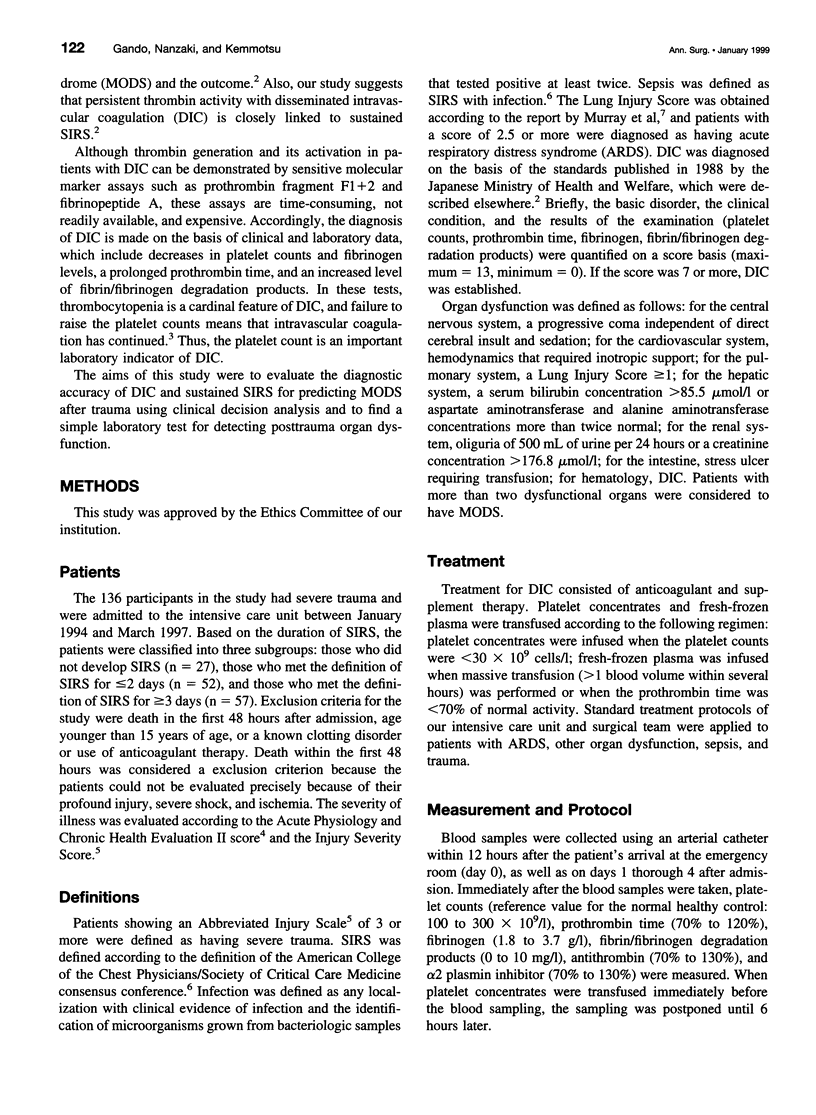Abstract
OBJECTIVE: To determine the accuracy of disseminated intravascular coagulation (DIC) and sustained systemic inflammatory response syndrome (SIRS) in predicting posttrauma multiple organ dysfunction syndrome (MODS) and to find a simple laboratory test for detecting MODS. SUMMARY AND BACKGROUND DATA: In trauma patients, the duration of SIRS is the main determinant for MODS and outcome. METHODS: One hundred thirty-six patients with trauma were classified into subgroups according to the duration of SIRS: patients without SIRS (n = 27), patients with SIRS for <2 days (n = 52), and patients with SIRS for > or =3 days (n = 57). Platelets and five coagulation and fibrinolytic laboratory tests for diagnosing DIC were measured on the day of admission and on days 1 through 4 after admission. Simultaneously, the DIC score was determined. The diagnostic accuracy of DIC and sustained SIRS for the prediction of MODS was determined using likelihood ratios. A receiver operating characteristic curve of platelet counts for predicting MODS was also constructed. RESULTS: Platelet counts showed significant differences among the three groups. The incidence of DIC, acute respiratory distress syndrome, and MODS was significantly higher in patients with SIRS for > or =3 days compared with those in the other groups, and they had a poor outcome. Likelihood ratios of DIC and SIRS for > or =3 days for predicting posttrauma MODS were 11.6 and 6.25, respectively. Platelet counts (80 x 10(9)/l) on day 1 had a sensitivity of 83.3% and a specificity of 100% for predicting MODS. CONCLUSIONS: Disseminated intravascular coagulation and sustained SIRS are strong determinants for posttrauma MODS. This retrospective analysis supports the possibility that platelet counts can be used as a simple laboratory test for predicting MODS. This hypothesis requires proof using a prospective clinical survey.
Full text
PDF






Selected References
These references are in PubMed. This may not be the complete list of references from this article.
- Civil I. D., Schwab C. W. The Abbreviated Injury Scale, 1985 revision: a condensed chart for clinical use. J Trauma. 1988 Jan;28(1):87–90. doi: 10.1097/00005373-198801000-00012. [DOI] [PubMed] [Google Scholar]
- Gando S., Kameue T., Nanzaki S., Hayakawa T., Nakanishi Y. Increased neutrophil elastase, persistent intravascular coagulation, and decreased fibrinolytic activity in patients with posttraumatic acute respiratory distress syndrome. J Trauma. 1997 Jun;42(6):1068–1072. doi: 10.1097/00005373-199706000-00014. [DOI] [PubMed] [Google Scholar]
- Gando S., Kameue T., Nanzaki S., Hayakawa T., Nakanishi Y. Participation of tissue factor and thrombin in posttraumatic systemic inflammatory syndrome. Crit Care Med. 1997 Nov;25(11):1820–1826. doi: 10.1097/00003246-199711000-00019. [DOI] [PubMed] [Google Scholar]
- Gando S., Kameue T., Nanzaki S., Nakanishi Y. Disseminated intravascular coagulation is a frequent complication of systemic inflammatory response syndrome. Thromb Haemost. 1996 Feb;75(2):224–228. [PubMed] [Google Scholar]
- Gando S., Nakanishi Y., Kameue T., Nanzaki S. Soluble thrombomodulin increases in patients with disseminated intravascular coagulation and in those with multiple organ dysfunction syndrome after trauma: role of neutrophil elastase. J Trauma. 1995 Oct;39(4):660–664. doi: 10.1097/00005373-199510000-00007. [DOI] [PubMed] [Google Scholar]
- Gando S., Nakanishi Y., Tedo I. Cytokines and plasminogen activator inhibitor-1 in posttrauma disseminated intravascular coagulation: relationship to multiple organ dysfunction syndrome. Crit Care Med. 1995 Nov;23(11):1835–1842. doi: 10.1097/00003246-199511000-00009. [DOI] [PubMed] [Google Scholar]
- Gando S., Tedo I., Kubota M. Posttrauma coagulation and fibrinolysis. Crit Care Med. 1992 May;20(5):594–600. doi: 10.1097/00003246-199205000-00009. [DOI] [PubMed] [Google Scholar]
- Hanley J. A., McNeil B. J. A method of comparing the areas under receiver operating characteristic curves derived from the same cases. Radiology. 1983 Sep;148(3):839–843. doi: 10.1148/radiology.148.3.6878708. [DOI] [PubMed] [Google Scholar]
- Hanley J. A., McNeil B. J. The meaning and use of the area under a receiver operating characteristic (ROC) curve. Radiology. 1982 Apr;143(1):29–36. doi: 10.1148/radiology.143.1.7063747. [DOI] [PubMed] [Google Scholar]
- Jaeschke R., Guyatt G. H., Sackett D. L. Users' guides to the medical literature. III. How to use an article about a diagnostic test. B. What are the results and will they help me in caring for my patients? The Evidence-Based Medicine Working Group. JAMA. 1994 Mar 2;271(9):703–707. doi: 10.1001/jama.271.9.703. [DOI] [PubMed] [Google Scholar]
- Knaus W. A., Draper E. A., Wagner D. P., Zimmerman J. E. APACHE II: a severity of disease classification system. Crit Care Med. 1985 Oct;13(10):818–829. [PubMed] [Google Scholar]
- Murray J. F., Matthay M. A., Luce J. M., Flick M. R. An expanded definition of the adult respiratory distress syndrome. Am Rev Respir Dis. 1988 Sep;138(3):720–723. doi: 10.1164/ajrccm/138.3.720. [DOI] [PubMed] [Google Scholar]
- Rangel-Frausto M. S., Pittet D., Costigan M., Hwang T., Davis C. S., Wenzel R. P. The natural history of the systemic inflammatory response syndrome (SIRS). A prospective study. JAMA. 1995 Jan 11;273(2):117–123. [PubMed] [Google Scholar]


